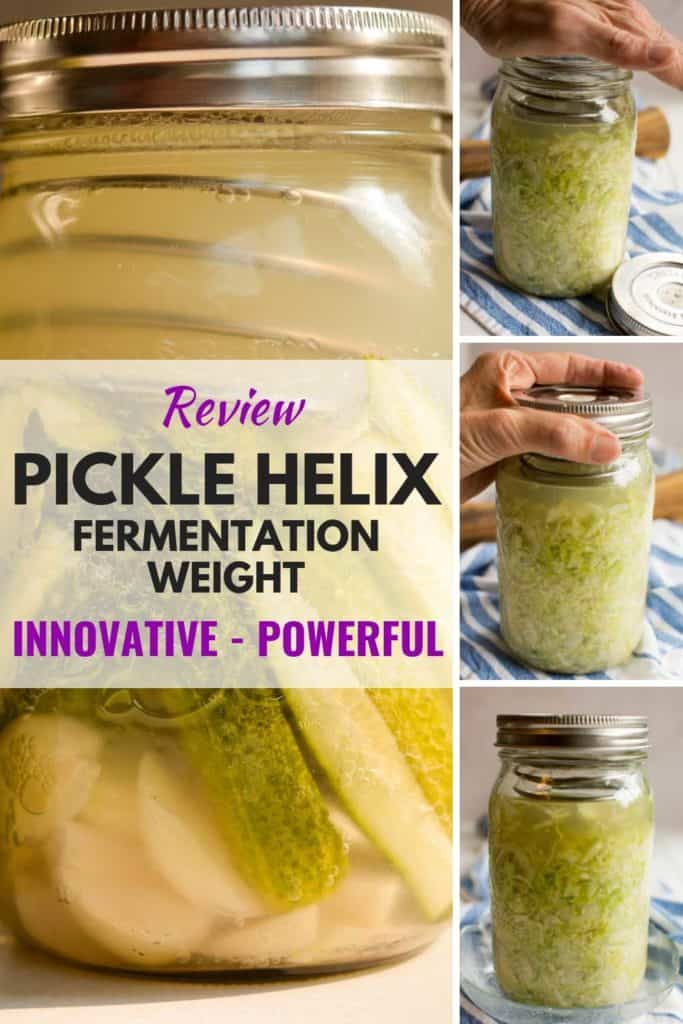The number one tip for successful fermentation is to keep your ferment below the brine.
Today I’m going to introduce you to my favorite fermentation weight—the PickleHelix—that does just this.
It’s powerful.
It’s innovative.
And, it holds just about any style of ferment below the brine for weeks.
I’ll share the pros and cons of it and show you how it has performed as a weight for sauerkraut, pickles, a pepper mash, and raisin chutney.
Let’s get started.
Note: Back in 2017, Trellis + Co. sent me their PickleHelix Stainless Steel Fermentation Jar Kit, that I reviewed for this post, as a gift.
Other fermentation weights that I have reviewed:
Pickle Pipe Pickle Pebble [MasonTops] REVIEW: Delightfully Simple
Pickle-Pushing No-Float Jar-Packer Review: Ingenious
Kraut Source Fermentation Lid REVIEW [Solid Design]
ViscoDisc Canning Buddies REVIEW [Simple & Affordable]
Review of the Trellis + Co. Stainless Steel Fermentation Jar Kit (PickleHelix)
The Trellis + Co. Stainless Steel Fermentation Jar Kit comes with a stainless steel lid that uses a waterless airlock valve for an airtight seal on your jar and a PickleHelix that uses the force of a coiled spring to hold your ferment below the brine.
The star player in the Trellis + Co. Stainless Steel Fermentation Jar Kit is the ingenious PickleHelix fermentation weight. The beauty in its design is that it is not a weight.
Historically, a heavy jug of water, a big can, or some large rocks were set on a plate inside an open ceramic crock of fermenting sauerkraut to hold everything below the brine. It’s taken us a while to move beyond the concept of using a weight to do this.
Josh, the co-founder of Trellis + Company, comes from an engineering background; engineering experience with springs to be more precise. His thinking helped to reinvent the “wheel” or in our case the fermentation weight.
Note: Trellis + Co. also sells mason jar lids, rims, sprouting kits, and a a cold coffee brewing kit, all made from stainless steel.
The forces created by the build-up of trapped gases in a packed mass of cabbage and vegetables can move mountains. Well, maybe not mountains, but in many cases they will move that popular glass disk up and out of your precious brine, exposing your ferment to air. Air where molds and yeasts can grow.
Those powerful gases are no match for the thick, stainless steel coiled spring of the PickleHelix.
During the first active stage of fermentation, the force of the PickleHelix not only keeps your ferment below the brine during but it also forces air bubbles up and out of your ferment.
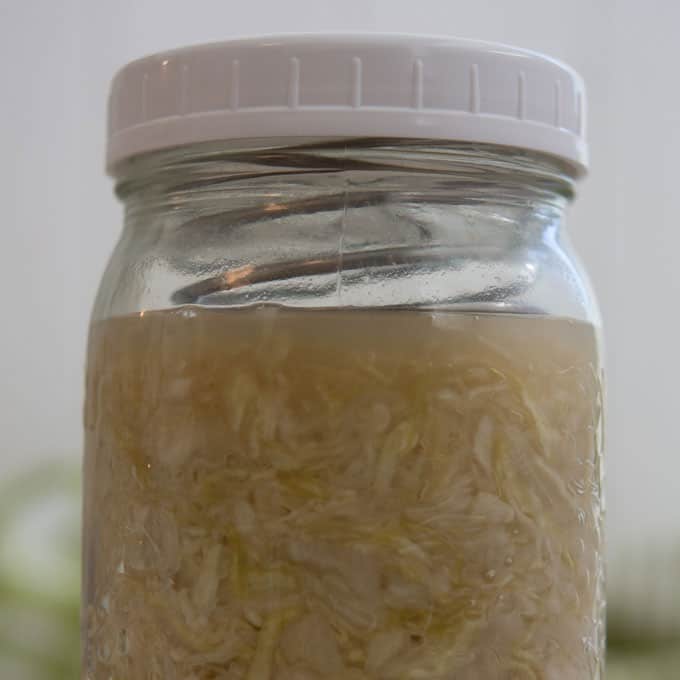
And, during the last quiet stage of fermentation, when brine gets pulled back into cabbage cells to leave your ferment high and dry, the PickleHelix exerts enough force to create a brine layer to keep your ferment safe as seen in the above picture as observed during my BEST Fermentation Weight for Fermenting in Jars [28-Day Challenge].
Pros of the PickleHelix
When I first started fermenting—back in 2001, my only options for a fermentation weight were marbles, small jars, rocks, and glass jewels. These options worked OK, but many were not food safe. My most effective weight was a glass jar filled with water.
Though you can’t seal the jar with a lid, this is still my number one recommendation for an effective “homemade” fermentation weight with more suggestions for keeping your ferment below the brine here.
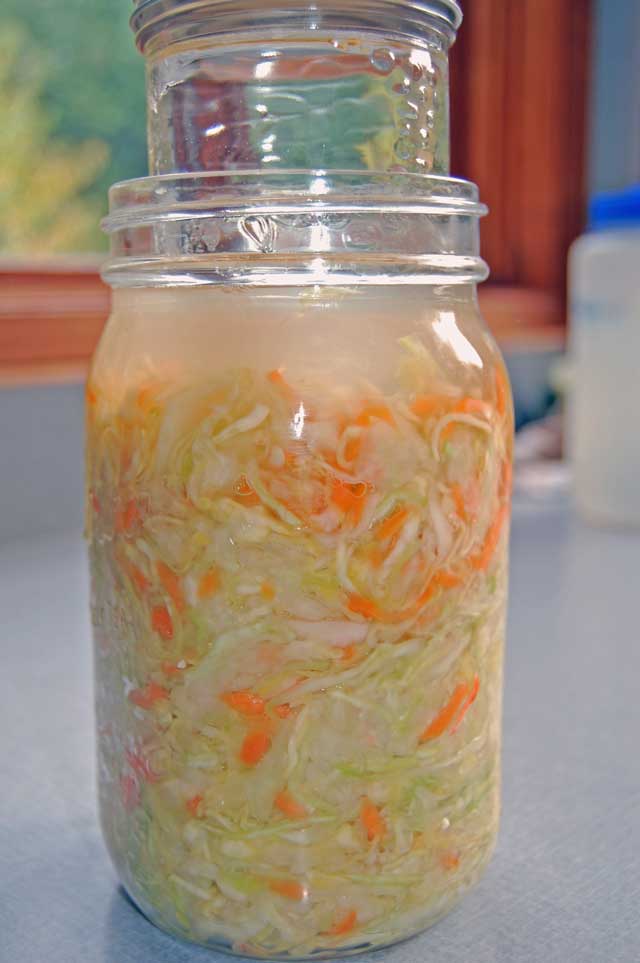
Then as fermentation became more popular, I reviewed some of the variety of weights came on the market: Pickle Pebble, Pickle Pusher, Canning Buddies, and Kraut Source. I’ve tried them all and found aspects of each to work well. But it wasn’t until I started using the PickleHelix that I realized the power in its simple, innovative design.
Seven reasons why I love the PickleHelix. The PickleHelix:
1. Doesn’t displace brine.
Glass weights and small jars work fairly good to hold a ferment below the brine but they take up precious space that is needed for brine. Brine is created as the salt you add pulls water out of the cabbage cells. In addition, gas pockets created by the bacteria displace brine.
The more space we have in the jar for the brine, the less likely it is to overflow, wasting precious brine. The coiled wire of the PickleHelix uses very little space, allowing plenty of space for brine.
2. Exerts a force three times greater than that of a glass weight.
I loved the glass weights when they first came out. They work, but…
They just are not heavy enough to keep an expanding ferment below the brine for the duration of fermentation.
When the brine is pulled back into the cabbage cells during the later stages of fermentation, it leaves your ferment high and dry. You have to push down on your packed ferment to keep the brine out and covering its surface. The PickleHelix pushes down with a force great enough to keep your ferment below the brine.
3. Automatically adjust to fermentation volume.
The Pickle Pusher and No products found. are two fermentation weights I use and love, but you have to pack your jar to just the right level for them to effectively work.
It doesn’t matter what height you pack your jar when using the PickleHelix. Whether your ferment is packed one inch or three inches from the top of the jar, the spring of the PickleHelix adjusts and still applies enough force on your ferment to keep it below the brine.
4. Is made with 316 stainless steel.
316 stainless steel is the most corrosion-resistant metal commercially available and is specifically designed for the highly acidic and salty fermentation environments. 316 stainless steel is used in implantable medical devices and pharmaceutical fermentations.
The most common form of stainless steel is 304. The 304-grade of stainless steel can withstand corrosion from most acids but is susceptible to corrosion from saline solutions, that is, the brine in your ferment!
Typical lids that come with Mason jars are made from 304 stainless steel and will corrode and rust during fermentation, which is very unhealthy and unappetizing. A better option for fermentation is the 316-grade of stainless steel, as is used with the PickleHelix.
5. Is super durable.
The gauge wire used in the PickleHelix makes it strong and sturdy. You are not going to accidental bend this wire. The Kraut Source Fermentation Kit also uses a spring. I don’t have worries about it bending, but it is made from a thinner wire and does not exert as much force as the PickleHelix.
6. Stainless Steel coil won’t absorb odors.
When you use stainless steel or glass, you don’t have to battle removing strong odors of onions, garlic, or tomato, as is the case with plastic or silicone.
Please note, however, that both the waterless airlock and the lid gasket for the stainless steel lid that can be purchased with the PickleHelix are made of silicone and will absorb odors.
7. Can grasp lid for easier removal.
Due to the movement of gases creating a vacuum seal during fermentation, lids can be near-to-impossible to remove. I notice an ever-so-slight give to the PickleHelix lid when I grasp it and try to unscrew it, making these lids a bit easier to remove.
In addition, the PickleHelix:
- Works with any sized wide-mouth jar, be that a quart (liter), pint (500 ml), or half-gallon (200 ml) jar. I recently used it to ferment half-gallon jars of shredded carrots. Carrots, with their high-sugar content, can be volatile and often bulge and overflow your jar. I didn’t have this usual problem when using the PickleHelix.
- Compresses to the thickness of a glass weight allowing more room for brine.
- Kit includes stainless steel lids with waterless, medical-grade fermentation valves.
- Is made in the USA.
- Company has excellent customer service; they respond to all Amazon comments and concerns.
Cons of the PickleHelix (and Stainless Steel Fermentation Lid)
Sadly, no fermentation weight is perfect. You have to weigh the pros and cons of each and then determine which fermentation weight will best meet your needs.
1. Doesn’t trap small bits.
The tightly coiled base of the PickleHelix spring is designed to act as a floaties trap. For most ferments—especially pastes and relishes, I find loose bits do float to the surface.
This drawback is easily solved by either folding up a piece of unbleached parchment paper or cutting a cabbage leaf to size and placing that on top of your packed ferment before inserting the PickleHelix.
2. Doesn’t work well with a watery mash.
The flat disk used with the Kraut Source Fermentation Lid works better for holding these styles of ferments below the brine.
3. Can’t be used with the Pickle Pipe fermentation lid.
The lid you use with the PickleHelix needs to be solid to order to hold the PickleHelix coil in place. The PickleHelix can be purchased as part of a fermentation kit that includes stainless steel fermentation lids.
Most of the other fermentation lids on the market—EasyFermenter, MasonLock, standard airlock lids, and the white plastic lid I often use—will work with the PickleHelix.
4. Waterless fermentation valve is easy to lose.
My dear husband washed my new fermentation lids not knowing there was a small valve in the lid. It fell out and was never found. I now make sure to wash them myself, removing the valve and placing it in a safe spot. However…
From Josh, the designer behind the PickleHelix:
We never, ever remove the valves here at home and therefore we never have to worry about losing them. If your valves are popping out too easily, get a replacement set and stop taking them out and you shouldn’t have any problems moving forward.
Get in touch with us and we’ll give you a coupon code for a new set of replacement valves. I don’t include extras because people would just lose them and they are surprisingly expensive (medical-grade, precision-molded components are not cheap).
5. Silicone valve and gasket in lid absorb odors.
On a microscopic level, silicone—and plastic—are porous and will absorb odors. I do remove the valve—and the lid gasket—and gently pat it with baking soda to absorb the odors as explained in this post.
My Favorite Tools FREE Download
Say goodbye to the guesswork and hello to deliciously fermented foods with these must-have fermentation tools.
Using the PickleHelix with Sauerkraut
I love how well the PickleHelix works with sauerkraut. Just be sure to use a torn cabbage leaf as a floaties trap.
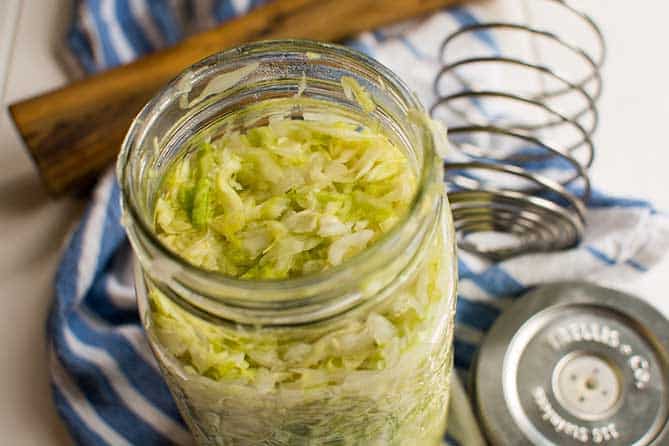
Once you pack your jar with your salted cabbage, just drop the PickleHelix into the jar. To prevent any loose bits from floating to the surface, I would recommend you first place a cabbage leaf cut to size into the jar.
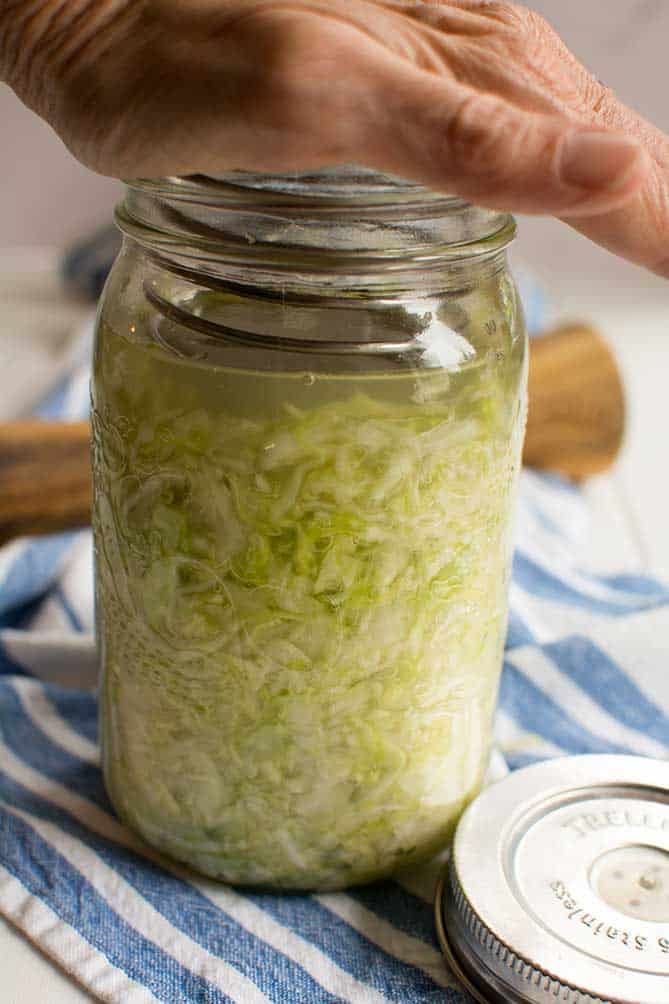
You can see how much brine is displaced by the force of the PickleHelix.
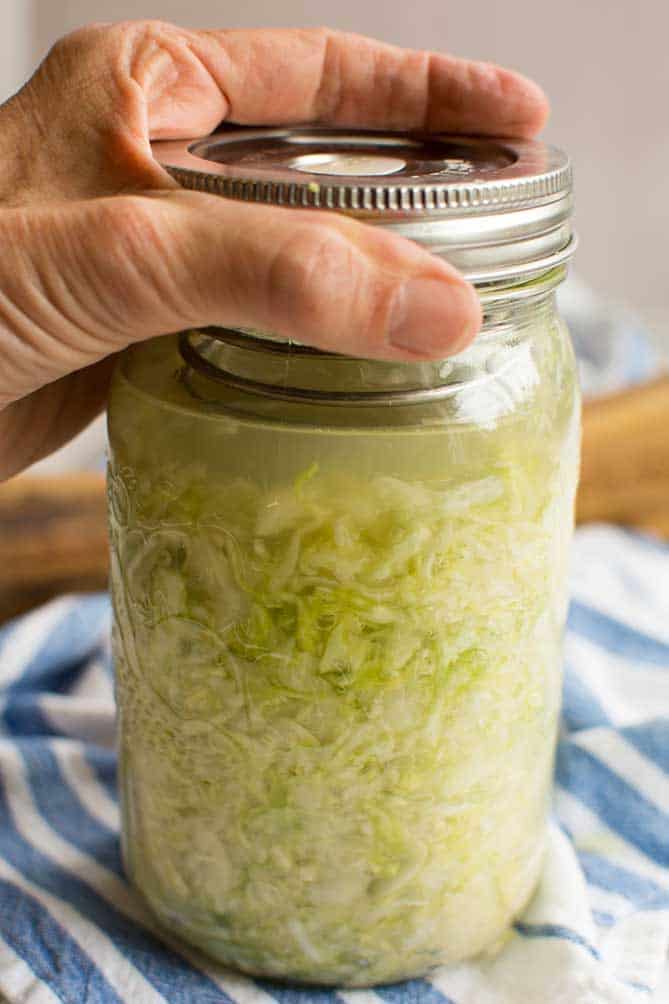
Screw the lid in place and your jar is ready for fermentation. Be sure to “seat” the valve in the center of the lid by lighting pressing down on it.
Gases that build up during fermentation will lift the valve and be released. The valve will then drop back down into place, keeping air from entering your jar.
Table of Popular Fermentation “Weights”
In the following table, I give an overview of the popular fermentation weights currently on the market and share their general pros and cons.
PickleHelix in Action with Various Types of Ferments
Here, I share the PickleHelix in use with a variety of ferments. The biggest challenge is holding back loose bits that like to work their way through the tight coil at the bottom of the PickleHelix. This problem is best solved by always using a Floaties Trap (a cabbage leaf cut to size or a piece of folded parchment paper).
Sauerkraut
I love how perfectly the PickleHelix works for fermenting a batch of sauerkraut. As I found out during my BEST Fermentation Weight for Fermenting in Jars [28-Day Challenge], it is able to keep the sauerkraut under brine for the duration of the fermentation period.
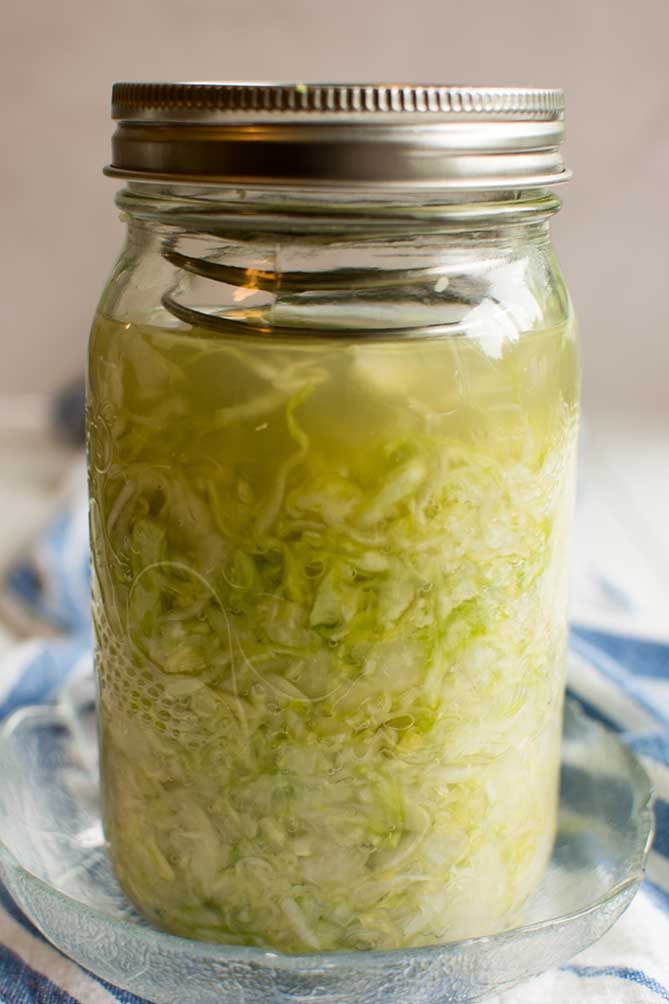
Cucumber Pickles
Loose vegetables, like cucumber spears, carrot sticks, or cubed vegetables can be a challenge to hold below the brine. I liked how well the PickleHelix worked with the cucumbers. Note how the spring has expanded to the height of the packed cucumber spears.
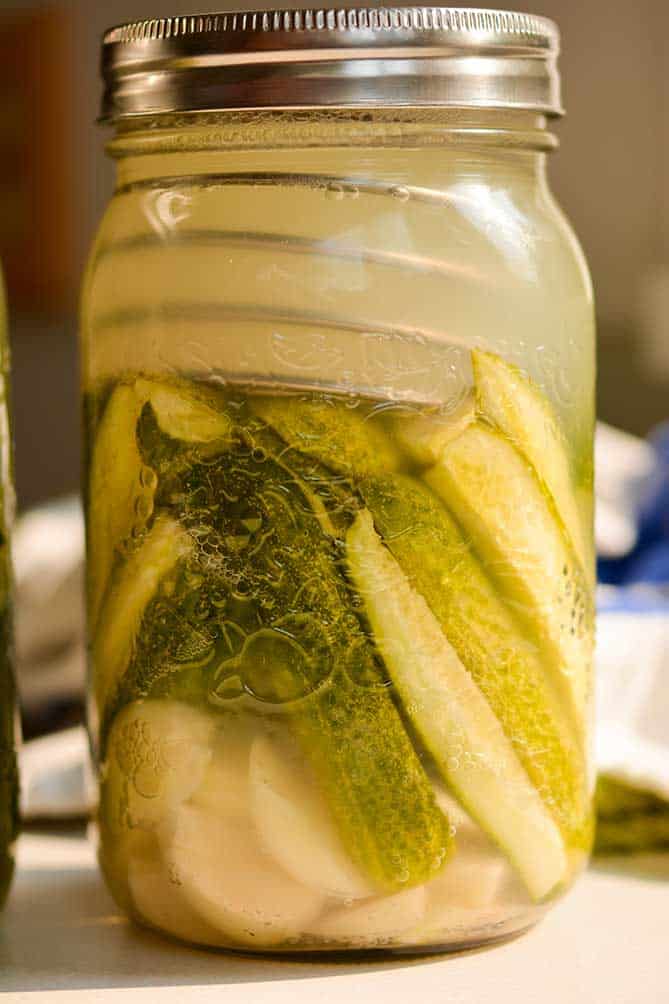
Raisin Chutney
With fermented pastes and relishes, it is hard to apply enough force to release enough brine to have it rise about the surface. This wasn’t a problem when using the PickleHelix with this batch of Raisin Chutney. Look at all that brine.
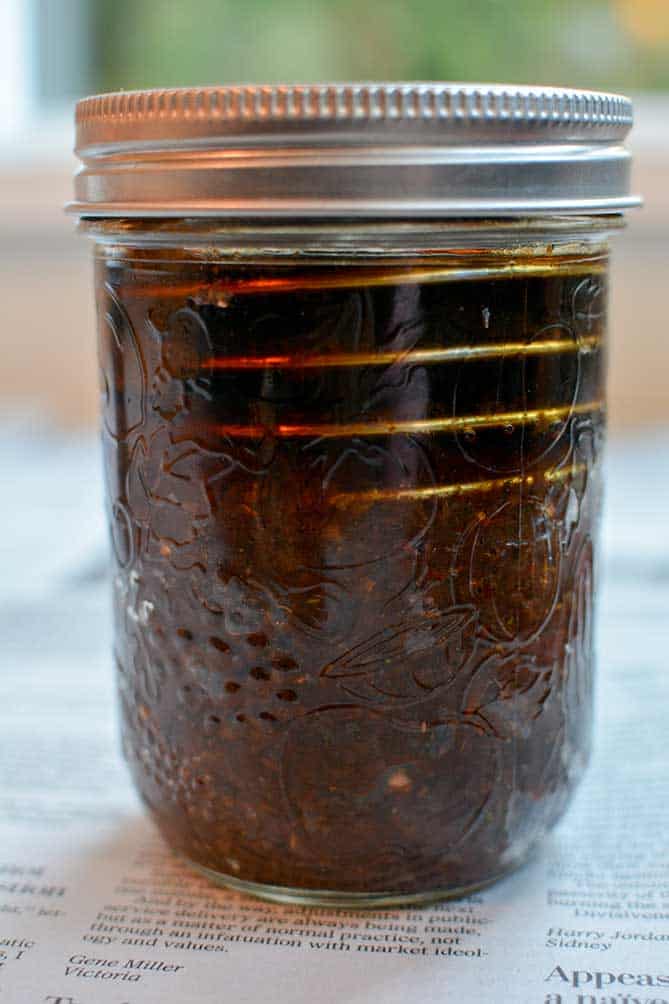
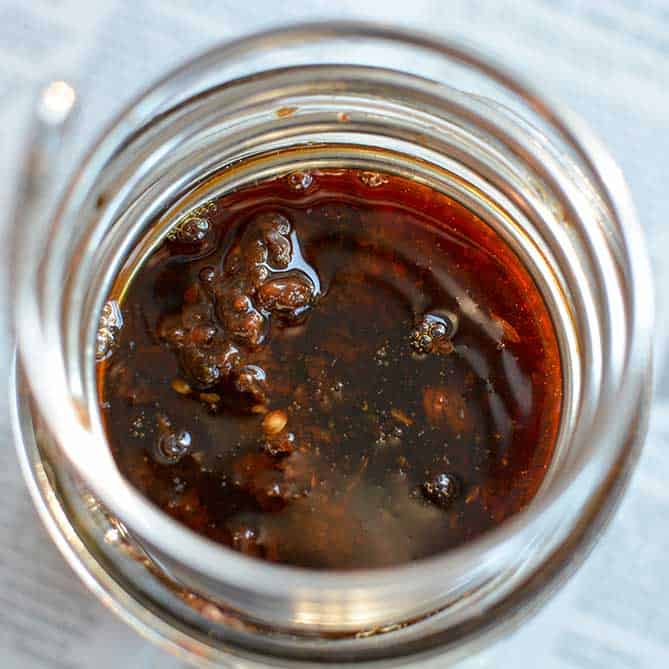
Pepper Mash
It can be near to impossible to find a weight to hold a pureed pepper mash below the brine. The Shockeys, authors of Fiery Ferments, have had good luck with a plastic freezer bag, filled with water.
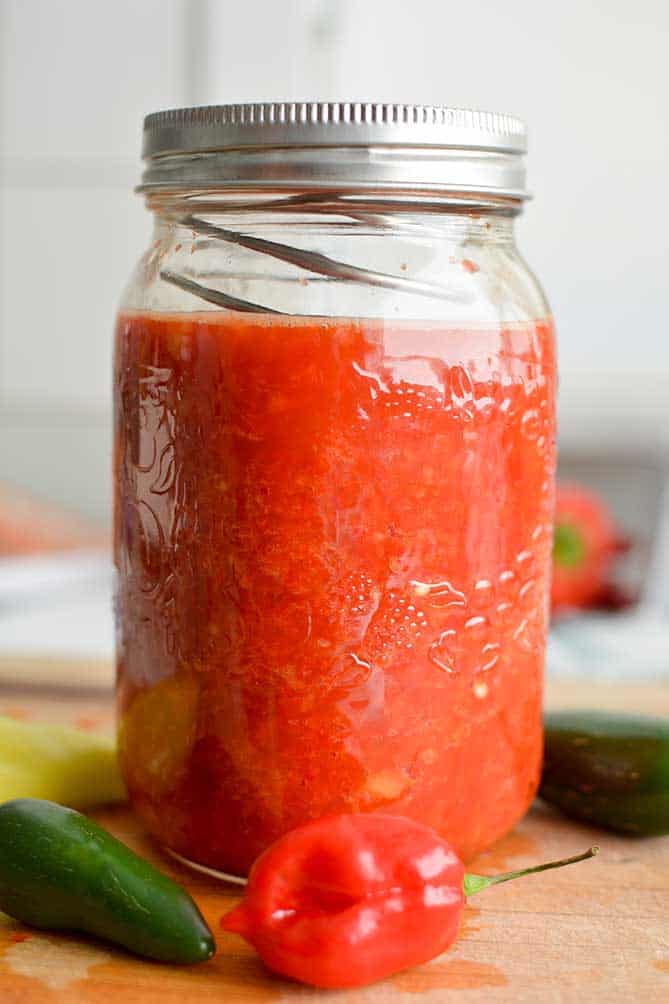
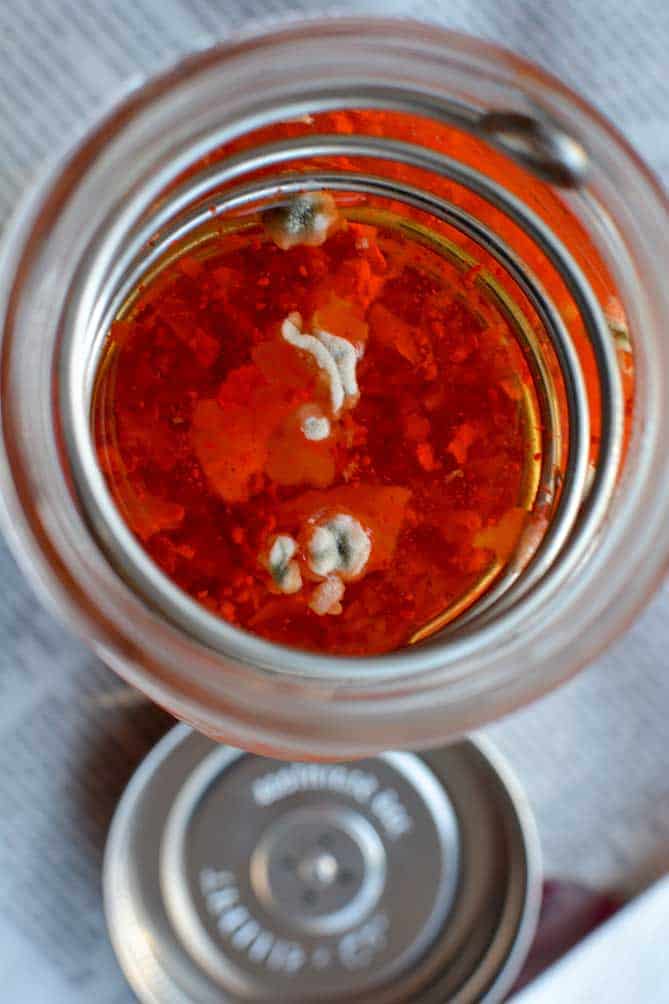
Cucumber Kimchi Relish
This is a watery relish recipe that I’m in the process of developing. I wanted to test the PickleHelix without any Floaties Trap as seen in the first image.
I then added a piece of folded parchment paper for a floaties trap and you can see that it works much better as seen in the second image.
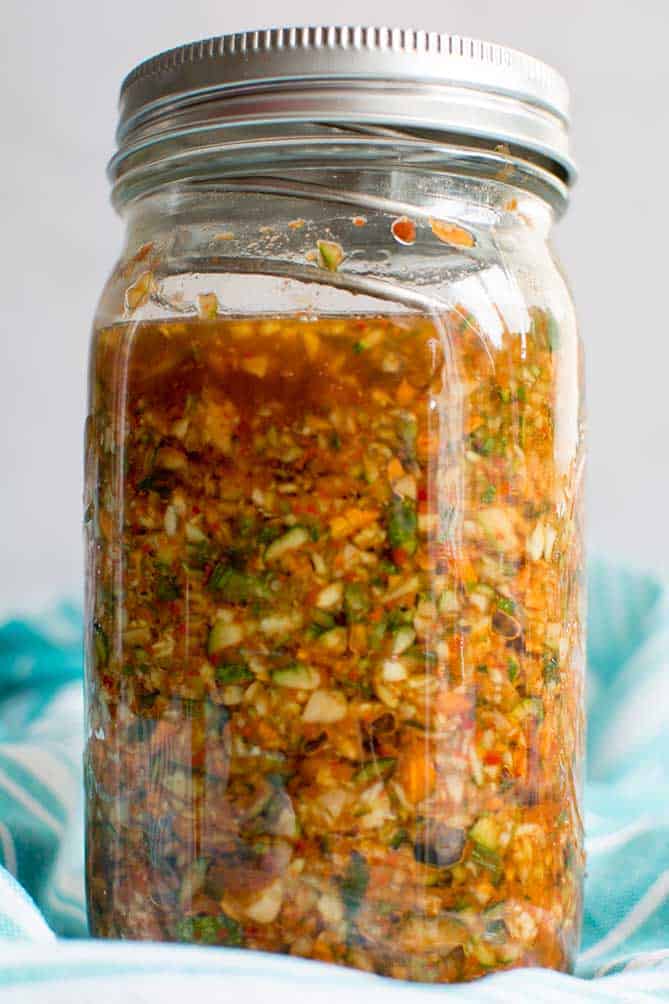
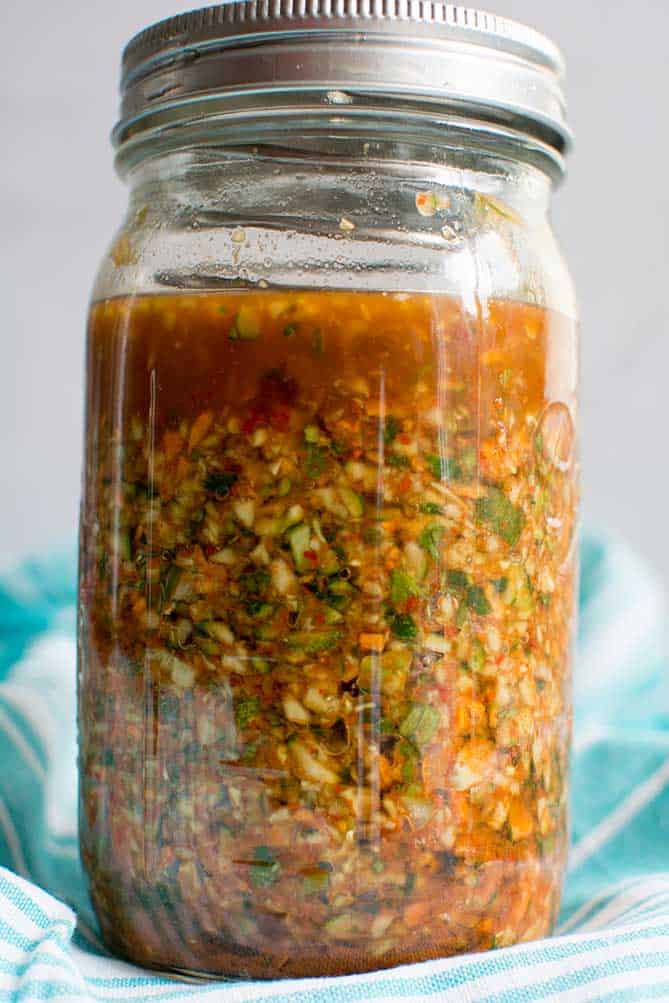
Brussels Sprout Kimchi Using the Kraut Source Lid
The Kraut Source Fermentation Lid (reviewed here) uses a flat plate as part of its design. You can see here how well it works to hold back loose bits.
However, the gauge wire used does not exert enough force to keep a batch of sauerkraut below the brine towards the end of the fermentation period when the brine wants to move back into the cabbage cells as seen in the next picture.
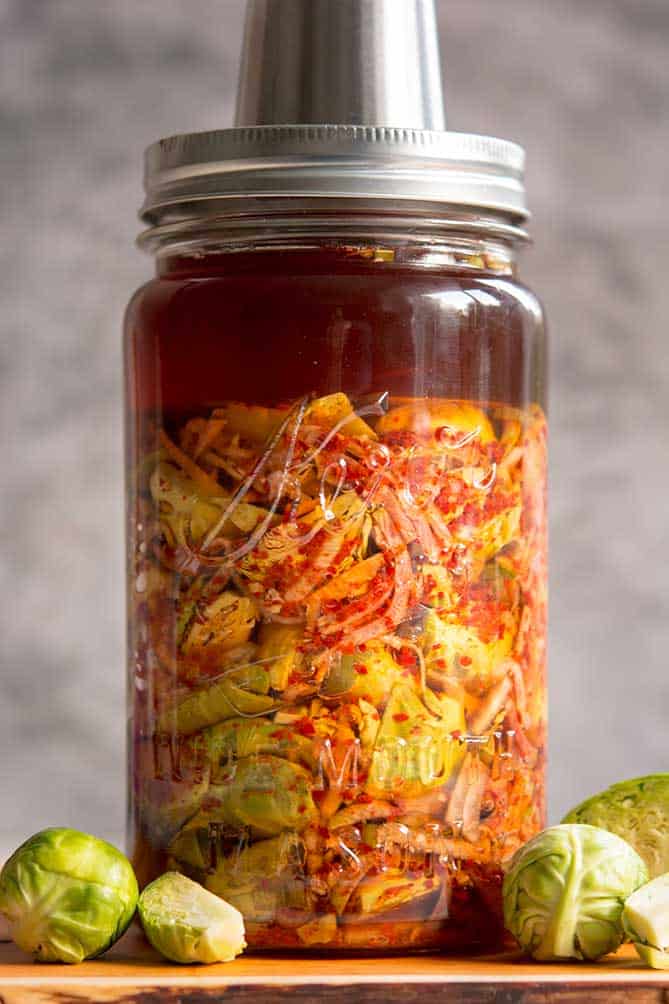
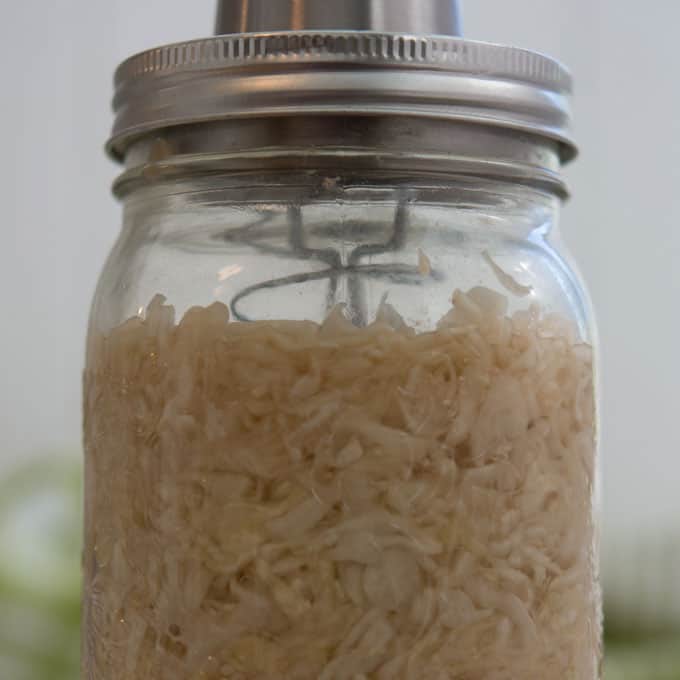
If you are looking to share your love of fermentation by gifting some fermentation tools to a special friend, I share the PickleHelix and more ideas in my fermentation gift guide.
My Favorite Tools FREE Download
Say goodbye to the guesswork and hello to deliciously fermented foods with these must-have fermentation tools.
There you have it. Will the innovative PickleHelix work for you? Let us know what fermentation weight has worked for you—or not, in the Comments Section below.

Last update on 2024-07-26 / Affiliate links / Images from Amazon Product Advertising API

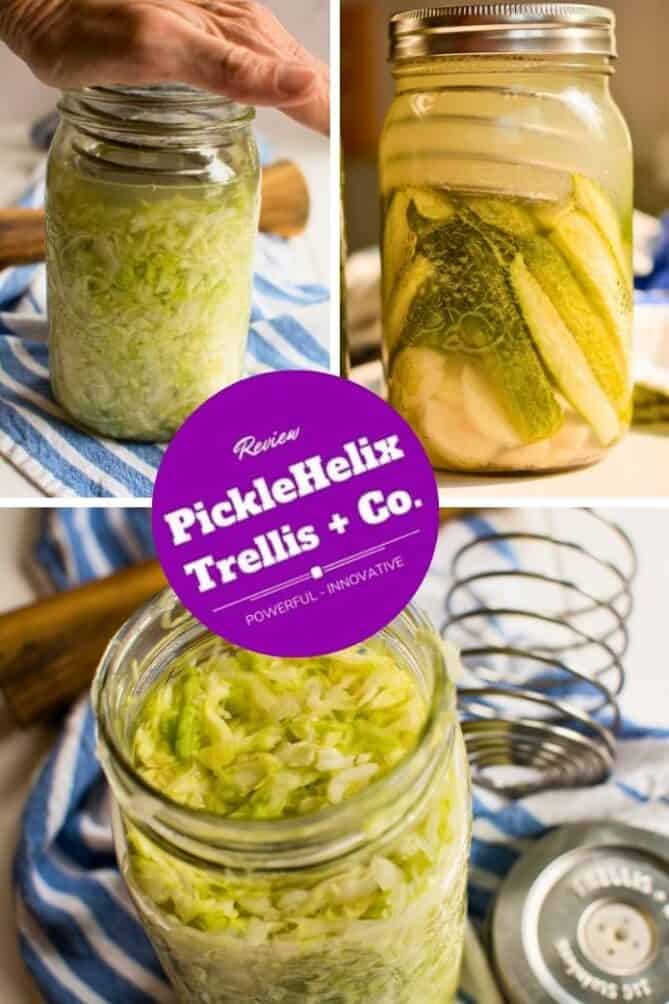

 This post may contain affiliate links which won’t change your price but will share some commission.
This post may contain affiliate links which won’t change your price but will share some commission.